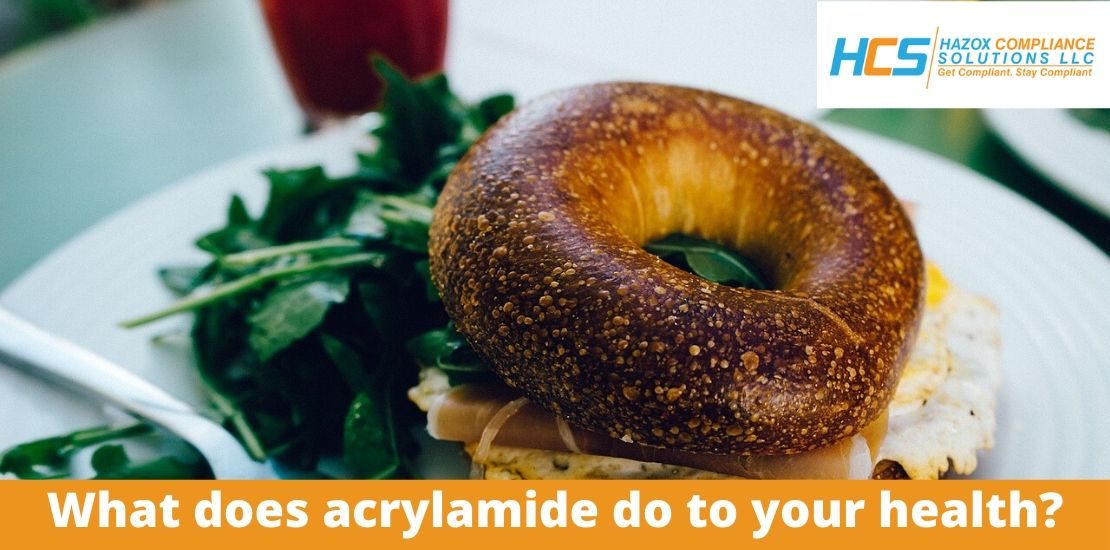- February 24, 2020
- Posted by: admin
- Category: Blogs

For a lot of people, Sunday means bagels, but did you know that the baking process can cause the formation of acrylamide in our bagels?
Acrylamide, a known carcinogen, is formed during high-temperature cooking. Traditional bagels are made using the two-step process. First, they are boiled after which they are baked at a high temperature to create that known chewy crust. It is this second part of the process that encourages the formation of acrylamide.
We, at Hazox, have created a campaign to let you know of harmful chemicals in your food that you may not be aware of.
In the first issue, we looked at what acrylamide is. If you have missed the first in the series, you can catch up here https://www.hazoxinc.com/potato-chips-contain-harmful-chemicals-that-you-may-not-know-about/ .
The second article looked at the range of foods acrylamide can be found at https://www.hazoxinc.com/pretzels-contain-harmful-chemicals-that-you-may-not-know-about/.
The third article looked at how acrylamide is formed in our foods and how the different cooking methods affect the amount of acrylamide formed. Find it at https://www.hazoxinc.com/cookies-hazardous-to-your-health-in-ways-you-wouldnt-think-about/
In the fourth article in the series, we looked at other sources of acrylamide besides food. Find it at https://www.hazoxinc.com/finally-the-weekend-is-here-its-time-to-sit-back-and-relax-with-that-cup-of-coffee-but-do-we-know-whats-really-in-it/
This article is going to look at the health effects caused by acrylamide by evaluating information currently available.
What does acrylamide do to your health?
Acrylamide, as discussed in previous issues, is neurotoxic in humans and animals, and is classified as a probable human carcinogen. Occupational exposure and smoking were originally considered the main sources of acrylamide exposure in humans, but it was later discovered that acrylamide was formed in a wide variety of carbohydrate-containing foods when fried or baked at high temperatures. This led to global concern for possible health effects of dietary acrylamide exposure, followed by studies to investigate the health problems associated with acrylamide exposure.
There are many human studies conducted to determine levels of acrylamide exposure, however, not much information is available about studies conducted on children or even prenatal exposure.
Prenatal exposure to acrylamide is of particular concern because of the reported reproductive and developmental toxicity of acrylamide in rodents, including dose-dependent bodyweight reduction and skeletal malformations in offspring exposed in utero.
Some of the studies seeking to obtain a correlation of acrylamide exposure are from research in Europe, including populations in several countries.
One study investigated the association between prenatal acrylamide exposure, fetal growth and birth weight. In that study, it was found that increased intake of acrylamide from the mother’s diet during pregnancy was associated with evidence of poor fetal growth based on a small increase in gestational age (SGA) and a reduction in birth weight; similar results were obtained after excluding women who smoked during pregnancy. As a result, a reduction in dietary acrylamide intake by pregnant women is suggested to benefit fetal growth.
In the case of studies with children, not much information is available, however, research measuring the urinary excretion levels of metabolites associated with acrylamide determined that the average absorption of acrylamide in children was 0.54 microg/kg body weight per day, exceeding the exposure in adults by 50%.
These findings support efforts to minimize acrylamide formation and food contamination. Similarly, this information can be compared with other human studies and suggests that children have a higher intake of acrylamide than adults, yet children oxidize it more effectively. Both findings indicate that children may be the most vulnerable group in the population due to dietary failures and excessive consumption of French fries, potato chips, and fried cereals. Therefore, efforts to implement balanced diets containing plenty of fresh foods should be maximized.
Tomorrow we will talk about another food product containing this hazardous chemical and look at the connection between acrylamides and cancer.
If you liked our article, please, share it, give us I like it and follow us in:
Facebook: https://www.facebook.com/HazoxComplianceSolutions
Twitter https://twitter.com/Hazox_Inc
LinkedIn https://www.linkedin.com/company/hazoxcompliancesolutions
Youtube: https://www.youtube.com/channel/UCIeBucyOUEtQFSAymS3TwQQ
